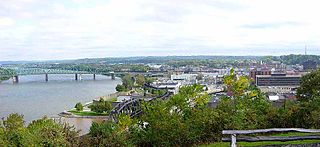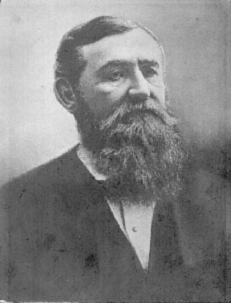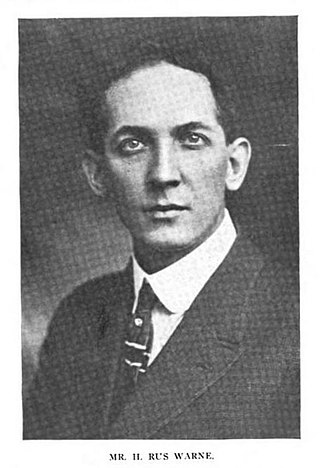
Parkersburg is a city in and the county seat of Wood County, West Virginia, United States. Located at the confluence of the Ohio and Little Kanawha rivers, it is the state's fourth-most populous city and the center of the Parkersburg–Vienna metropolitan area. The city's population was 29,749 at the 2020 census, and its metro population was 89,490. The city is about 14 miles (23 km) south of Marietta, Ohio.

Johnson Newlon Camden was a prominent oilman, industrialist, banker, railroad tycoon, and politician who was estimated to be worth $25 million at the time of his unexpected death. Although both of his attempts to become governor of the new state of West Virginia failed, he did become United States Senator, representing West Virginia on two occasions.

The W.H. Bickel Estate is a 2+1⁄2-story stone mansion built between 1928 and 1930 on the outskirts of Parkersburg, West Virginia. The 1,800-square-foot (170 m2) building has a rectangular main section and a wing to the East. It is known for its architecture and a ghost that reportedly haunts the area. The main house is rich with woodwork, including intricately inlaid walnut and maple floors with geometric patterns, wood mantels, partial wainscoting on all three floors, 15 light French doors on the first floor, solid maple arched doors on the second floor, built-in china cabinets, crown molding in all main rooms, and original finish wood casement windows with roll down screens and brass hardware. There are five gas fireplaces with marble or stone hearths in the main house and two staircases, including a circular walnut and maple main staircase. The ceilings are coved on the second and third floors, and the third floor contains a ballroom or “dance hall” stretching twenty eight feet.

The Parkersburg Bridge crosses the Ohio River between Parkersburg, West Virginia, and Belpre, Ohio. Designed by Jacob Linville, the bridge has 46 spans: 25 deck plate girder, 14 deck truss, 6 through truss, and 1 through plate girder. 50,000 cubic yards (38,000 m3) of stone were used for the 53 piers. The bridge was constructed from May 1869 to January 1871 by the Baltimore and Ohio Railroad. At the time of its completion, the bridge was reportedly the longest in the world at 7,140 feet (2,180 m).

Jacob Beeson Jackson was the sixth Governor of West Virginia from 1881 to 1885. In 1855, he married Maria Willard. In his biography it is stated that he was a cousin of Stonewall Jackson. An examination of their family trees shows that the two men were second cousins once removed. He was also a 4th-cousin-once-removed to William Wirt Woodson who was Stonewall Jackson's half brother.

The Ogle County Courthouse is a National Register of Historic Places listing in the Ogle County, Illinois, county seat of Oregon. The building stands on a public square in the city's downtown commercial district. The current structure was completed in 1891 and was preceded by two other buildings, one of which was destroyed by a group of outlaws. Following the destruction of the courthouse, the county was without a judicial building for a period during the 1840s. The Ogle County Courthouse was designed by Chicago architect George O. Garnsey in the Romanesque Revival style of architecture. The ridged roof is dominated by its wooden cupola which stands out at a distance.

The Wood County Courthouse is a public building in downtown Parkersburg, West Virginia, in the United States. The courthouse was built in 1899 at a cost of $100,000 in the Richardsonian Romanesque style by local contractors Caldwell & Drake, according to the plans of architect L. W. Thomas of Canton, Ohio. The current courthouse is the fifth to be built in the county replacing one built in 1860. It was added to the National Register of Historic Places in 1979 for its architectural significance. During his 1912 presidential campaign Theodore Roosevelt stopped in Parkersburg and spoke from the Market street entrance of the courthouse. On 2 July 2020 a new steeple was added to the bell tower replacing one that had been removed in 1952. With the new steeple the courthouse is now the tallest in the state at 164 ft.

James Monroe Jackson was a lawyer and Democratic politician from West Virginia who served as a United States Representative in the 51st United States Congress.

John Jay Jackson Jr. was an American lawyer, Whig politician, United States District Judge and, later, the first judge of the United States District Court for the District of West Virginia. He ended his career as the first judge of the United States District Court for the Northern District of West Virginia.

The Alexandria City Hall also known as the Alexandria Market House & City Hall, in Alexandria, Virginia, is a building built in 1871 and designed by Adolph Cluss. In 1984, the building was listed on the U.S. National Register of Historic Places.

Blennerhassett Hotel is a historic hotel located at Parkersburg, Wood County, West Virginia. It opened in 1889 and is in the Queen Anne style. The hotel was listed on the National Register of Historic Places in 1982. A full restoration took place in 1986.

Henry Logan Memorial African Methodist Episcopal Church is a historic African Methodist Episcopal church at Ann & 6th Streets in Parkersburg, Wood County, West Virginia. It was built in 1891, and is a brick and stone church building in a vernacular Romanesque style. It features three round arched stained glass windows on the front facade and a square, pyramidal roofed corner tower.

St. Francis Xavier Church is a historic church at 532 Market Street in Parkersburg, West Virginia.

Herman Davis State Park is a 1-acre (0.40 ha) state park in Manila, Arkansas, United States. The park includes the grave of and a memorial to Herman Davis (1888-1923), a U.S. sniper during World War I. The park is located at the junction of Baltimore Avenue and Arkansas Highway 18, south of the city center. It consists of a grassy area, with a concrete walk leading to the memorial. The memorial is a granite obelisk, 25 feet (7.6 m) in height, in front of which stands a full-size granite likeness of Davis in his infantry uniform. Davis' remains are buried just behind the monument. Davis is also honored with a fountain on the grounds of the Old State House in Little Rock. The fountain was a part of the Arkansas exhibition at the 1876 Philadelphia Centennial Exposition. In 1954, the three-tiered iron fountain was renamed the Herman Davis Memorial Fountain. Davis, a native of Manila, won distinction in the war for taking out a nest of German machine gunners with his marksmanship. Davis was a modest man and rarely mentioned the awards he received for this and other actions, but was called out by General John J. Pershing, who placed him fourth on a list of 100 heroes of the war.

The Dillon Memorial is a historic structure located in LeClaire Park, near downtown Davenport, Iowa, United States. It was listed on the National Register of Historic Places (NRHP) in 1983 and on the Davenport Register of Historic Properties in 1993. It is commonly referred to as the Dillon Fountain.

Harry Rus Warne was a Charleston, West Virginia-based architect.

The Parkersburg Carnegie Library is a historic library building located at Parkersburg, Wood County, West Virginia. It was designed and built in 1905, with funds provided by the philanthropist Andrew Carnegie. It is one of 3,000 such libraries constructed between 1885 and 1919. Carnegie provided $34,000 toward the construction of the Parkersburg library. It is a two-story, L-shaped brick structure in the Classical Revival style. The facade is detailed in gray stone and features a pediment with two Doric order columns. It ceased use as a library about 1975, and in December 1985, it was re-opened, as Trans Allegheny Books, which was the largest used book store in West Virginia until it closed in 2010.

Henry Cooper House, also known as The Daughters of American Pioneers Museum and Cooper Cabin, is a historic home located at Parkersburg, Wood County, West Virginia. The log cabin was erected in Slate District, Wood County, in 1804, by Henry Cooper, and is believed to be the first two-story log cabin in Wood County. In August 1910, the City of Parkersburg purchased the structure for $400. After being dismantled, the house was rebuilt in the Park in September 1910. In 1911, title was granted by the City Council to the Centennial Chapter - Daughters of American Pioneers. The cabin is open as a museum.

The Giles J. Gibbs Building, also known as the Sugar Bowl, is a commercial building located at 12 North Clinton Avenue in St. Johns, Michigan. It was listed on the National Register of Historic Places in 2000.
Tarboro Town Common is a historic town common located at Tarboro, Edgecombe County, North Carolina. The common was established in 1760, and is an open space containing several memorials and a fountain. It originally consisted of 50 acres (20 ha). The commons contains five contributing objects: the Cotton Press; a Confederate memorial (1904); an obelisk; a memorial to the Spanish–American War dead; and a two-tier, cast iron fountain.























